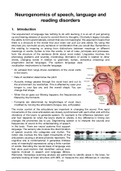Neurogenomics of speech, language and
reading disorders
1. Introduction
The acquirement of language has nothing to do with learning, it is an art of just growing
up and hearing streams of sound to convert them to thoughts. Chomsky’s legacy includes
the ability to form grammatically correct that are not meaningful. His argument means that
there is a structure in the words that your brain can pull out and sense. By using this
structure you can build up any sentence or combination that you would like. Semantics is
the relating to meaning or arising from distinctions between meanings or different
meanings or words. Syntax is how the words, in set of rules, principles and processes,
form the structure of the sentence (think about word order). Linguistics involves; the
phonology (patterns and sounds), morphology (formation of words in relation to other
words, changing words in relation to grammar), syntax, semantics (meaning) and
pragmatics (social language). The spoken language uses
vocalization mechanisms to transfer language.
- Air exhaled from lungs drives oscillations of the vocal cords
in the larynx.
- Rate of oscillation determines the pitch
- Acoustic energy passes through the vocal tract and out to
the environment via nosrils/lips. This is affected by were your
tongue is, your lips are, and the overall shape. You can
change that shape
- When the air goes out filtering happens; the frequencies are
filtered by the formants
- Formants are determined by length/shape of vocal tract;
modified by moving the articulators (tongue, lips, soft palate)
The motor control of the articulators are important in changing the sound. Fine rapid
movements of the vocal articulators are closely synchronized with each other and with the
vibrations of the larynx to generate speech. An example is the difference between ‘pat’
and ‘bat’ depends on when the larynx starts to vibrate. A tiny difference in timing can
changes the phonemes (ba to pa). Segmenting speech is to interpret the sounds and
frequencies of sound to the understanding of speech
in the brain. There are neural systems that support
language. The sensory site involves the discrimination
of speech sounds into categories and rhythm. The
motor site involves the fine rapid movements of the
articulators causing a diverse phonetic repertoire. The
cognitive site is combinatorial; it generates limitless
array of meaningful expressions using a finite number
of words. Decoding the neural basis of language was
first done post-mortem that identified various brain
regions involved in speech and language (Broca,
Wernicke). Nowadays scanning analysis are performed to identify areas in the brain, for
example looking at brain structure with MRI, or measure the size differences in volumes
, and regions, or look at cortex thickness, or look at
axons and neuronal tacts. Another thing you can do
is to look at the flow of oxygen at different sites of
the brain, which parts of the brain are more active
after a language task (functional MRI). Auditory
guided vocal learning means that you have to figure
out yourself how a certain sound coming from
someone from your species is translated into words
and mimic the same speech. So one person learns
the language of that species to survive from another
person by hearing and repeating. Chimpanzees are
the closest relatives to the human being, but why is
it the case that they cannot speak? There are
anatomical differences in the vocal tracts between
the species. The main difference is that the
chimpanzee has an air sac, of which the function is still unknown. The dept of the larynx
is also different, human have a lower larynx and a flatter vocal cord compared to primates
that makes a different shape of the vocal tracts (more space for tongue etc to move).
However, recently it has been found that many species pull down their larynx to produce
more tones, so this statement above is not completely true. Now, more research is
focussed on the motor control in the brain to coordinate the complex movements of the
vocal cords etc. There are a few language, speech and reading disorders;
- Developmental Dyslexia/Reading disability: A difficult with reading and spelling that
cannot be explained by obvious causes, including low IQ. These difficulties persist from
school-age children to adulthood
- Specific language impairment (SLI): Unexplained impairment in acquisition of spoken
language, affecting one or more morphology, syntax, semantics and pragmatics
- Developmental verbal dyslexia (DVD)/childhood apraxia of speech (CAS): Problems
with learning to make coordinated movements needed for speech. Typically
accompanied by additional deficits in language function, both oral as written
When defining the phenotype of a person with a disorder you can look at the affection
status, which is the qualitative all-or-none diagnoses based on discrepancy between
ability and that expected from age and IQ. The quantitative assessment of ability is the
direct use of test scores in subsequent genetic analyses. Phenotypic complexity is a
major confounding factor for genetic analyses of these disorders.
2. Rare Mendelian forms
A subset of children grow up in language-rich environments, but do not develop normal
skills. Sometimes there is no overt cause of the disorder, such as hearing loss or mental
retardation. Developmental language disorders are often found in clusters of families. Twin
studies consistently indicate high heritability to explain the role for genetic factors. If the
DNA variant can be identified then the protein the gene codes for can be identified and
we can say something about the function of the protein in the cell. The main cells that are
important in speech and language are neurons, so the question is how these proteins
affect the neurons, the neural circuits and the brain eventually leading to the disorder.
There are various genetic variations leading to disorders;





